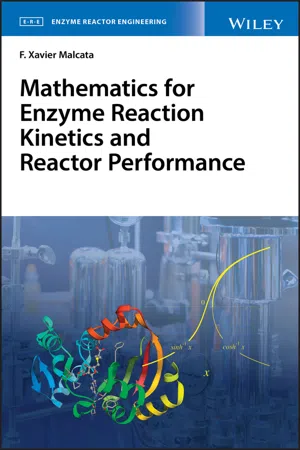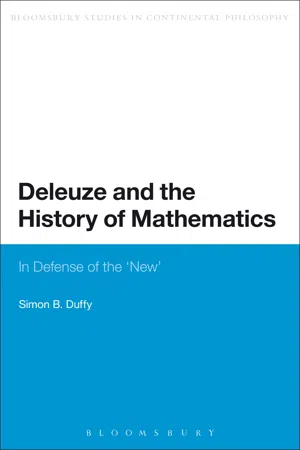Continuity Over an Interval
Continuity over an interval refers to a function being continuous for all values within a specific range of numbers. In mathematical terms, a function is continuous over an interval if it is continuous at every point within that interval. This concept is important for understanding the behavior of functions and their graphical representations.
6 Key excerpts on "Continuity Over an Interval"
- F. Xavier Malcata(Author)
- 2020(Publication Date)
- Wiley(Publisher)
...Such a realization does not hold when the numbers are rational (because of lack of irrational numbers to fill in between), and even less in the case of integer numbers (as both rational and irrational numbers would be absent). To better illustrate this point, one may resort to counterexamples of functions that are not continuous – as depicted in Fig. 9.3 b and c, vis‐à‐vis with the corresponding continuous function in Fig. 9.3 a. Although continuity can be defined in several different ways, the idea that the graph of a continuous function has no breaks in it within the whole interval] a,b [ is the simplest concept (see Fig. 9.3 a); this is equivalent to stating that close points in the x domain map to close points in the f { x } domain. Conversely, a jump is undergone by the function at x = c in Fig. 9.3 b and c that makes f { x } discontinuous at x = c ; the latter may, however, be reconverted to a continuous function if f { c } is reset to d. Figure 9.3 Graphical representation of function f { x }, (a) continuous within interval] a,b [ or (b, c) discontinuous only at x = c ∈ ] a, b [ – with (b) and in the left and right vicinities, respectively, of c, and (a, c) in the vicinity of c – with (b) concomitant inexistence of and (c). Mathematically speaking, a function f { x } is said to be continuous at point x = a if whichever sequence (a n) converging to a implies that sequence (f { a n }) converges. to f { a }, i.e. (9.138) this statement implies that both and f { a } must exist, and further that they must be equal. A similar definition can be conceptualized for a multivariate function, although being of a lesser usefulness in practice. In view of Eq. (9.138), one may resort to Eqs...
- eBook - ePub
- Gregory Hill, Mel Friedman(Authors)
- 2013(Publication Date)
- Research & Education Association(Publisher)
...You should remember that y = ln(x), y = tan(x), and y = sec(x) all have vertical asymptotes. In addition, the greatest integer function has jump discontinuities at every integer in its domain. CONTINUITY OF A FUNCTION In the absence of a stated domain, a function is continuous if it is continuous at every point of its domain. Interestingly, this means that, for instance, is considered a continuous function since x = 0 is not in its domain, even though most people would see it as being discontinuous at its vertical asymptote. Fortunately, this approach to continuity of functions is rarely used in introductory calculus courses. Most often, one is asked to determine continuity over a stated domain, or determine points of discontinuity over the real numbers. In this context, is not continuous over the real numbers. EXAMPLE 2.12 On the domain [–4, 4], where is discontinuous? SOLUTION Zeros in the denominator cause discontinuities, so f (x) is discontinuous at x = 2 and x = –2. It is also important to note that any algebraic combination of continuous functions is also a continuous function with the exception of division by a function with a value of 0. If g and h are continuous at a, then the following algebraic combinations of functions are continuous at a : 1) g±h 2) g.h 3) if h (a) ≠ 0 Additionally, a composition of continuous functions is also continuous. If g is continuous at a, and h is continuous at g (a), then h (g (x)) is also. continuous at a. One of the most important immediate consequences of continuity is the Intermediate Value Theorem. We state it without proof. Intermediate Value Theorem Let f be continuous on the closed interval [ a, b ], and let M be any number between f (a) and f (b). There exists a number c in (a, b) such that f (c) = M. Informally, this theorem says that on a given interval [ a, b ], a continuous function will, at least once, take on all y-values between f (a) and f (b)...
- eBook - ePub
- Frank J. Fabozzi, Frank J. Fabozzi(Authors)
- 2012(Publication Date)
- Wiley(Publisher)
...The general idea behind continuity is that the graph of f (x) does not exhibit gaps. In other words, f (x) can be thought of as being seamless. We illustrate this in Figure 1. For increasing x, from x = 0 to x = 2, we can move along the graph of f (x) without ever having to jump. In the figure, the graph is generated by the two functions f (x) = x 2 for x ∈ [0,1), and f (x) = ln(x) + 1 for x ∈ [1, 2). Note that the function f (x) = ln (x) is the natural logarithm. It is the inverse function to the exponential function g (x) = e x where e = 2.7183 is the Euler constant. The inverse has the effect that f (g (x)) = ln(e x) = x, that is, ln and e cancel each other out. A function f (x) is discontinuous if we have to jump when we move along the graph of the function. For example, consider the graph in Figure 2. Approaching x = 1 from the left, we have to jump from f (x) = 1 to f (1) = 0. Thus, the function f is discontinuous at x = 1. Here, f is given by f (x) = x 2 for x ∈ [0,1), and f (x) = ln(x) for x ∈ [1,2). Figure 3 Continuity Criterion Note : Function f = sin(x), for −1 ≤ x ≤ 1. Formal Derivation For a formal treatment of continuity, we first concentrate on the behavior of f at a particular value x*. We say that that a function f (x) is continuous at x * if, for any positive distance δ, we obtain a related distance ε (δ) such that What does that mean? We use Figure 3 to illustrate. (The function is f (x) = sin(x) with x * = 0.2.) At x *, we have the value f (x *). Now, we select a neighborhood around f (x *) of some arbitrary distance δ as indicated by the dashed horizontal lines through f (x *) − δ and f (x *) + δ, respectively. From the intersections of these horizontal lines and the function graph (solid line), we extend two vertical dash-dotted lines down to the x -axis so that we obtain the two values x L and x U, respectively. Now, we measure the distance between x L and x * and also the distance between x U and x *...
- Stu Schwartz(Author)
- 2013(Publication Date)
- Research & Education Association(Publisher)
...So this is a “bottom-heavy” expression and DID YOU KNOW The sine and cosine functions are fundamental to the theory of periodic functions as those that describe sound and light waves. Continuity Overview: A very loose definition of a continuous curve is one that can be drawn without picking up the pencil from the paper. Lines are continuous, parabolas are continuous, and so are sine curves. But for more complex curves, we need a definition that can prove where a function is continuous. A function f (x) is continuous at x = c if all three conditions hold: What this says is that the limit must exist at x = c, the function must have a value at x = c, and that this limit and value must be the same. If a function is continuous at all values c in its domain, the function is continuous. EXAMPLE 24: For each of the following functions, examine their graphs and determine if the function is continuous at the given value of x and, if not, which of the rules of continuity above it fails. SOLUTIONS: a. is not continuous at x = 2 because does not exist. b. is not continuous at x = 3 because f (3) does not exist. c. is not continuous at x = 0 because d. is continuous at x = –3. e. is not continuous at x = 1 because does not exist and f (1) does not exist. f. While this...
- eBook - ePub
- Bertrand Russell(Author)
- 2014(Publication Date)
- Routledge(Publisher)
...The application to actual space and time will not be in question to begin with. I do not see any reason to suppose that the points and instants which mathematicians introduce in dealing with space and time are actual physically existing entities, but I do see reason to suppose that the continuity of actual space and time may be more or less analogous to mathematical continuity. The theory of mathematical continuity is an abstract logical theory, not dependent for its validity upon any properties of actual space and time. What is claimed for it is that, when it is understood, certain characteristics of space and time, previously very hard to analyse, are found not to present any logical difficulty. What we know empirically about space and time is insufficient to enable us to decide between various mathematically possible alternatives, but these alternatives are all fully intelligible and fully adequate to the observed facts. For the present, however, it will be well to forget space and time and the continuity of sensible change, in order to return to these topics equipped with the weapons provided by the abstract theory of continuity. Continuity, in mathematics, is a property only possible to a series of terms, i.e. to terms arranged in an order, so that we can say of any two that one comes before the other. Numbers in order of magnitude, the points on a line from left to right, the moments of time from earlier to later, are instances of series. The notion of order, which is here introduced, is one which is not required in the theory of cardinal number. It is possible to know that two classes have the same number of terms without knowing any order in which they are to be taken. We have an instance of this in such a case as English husbands and English wives: we can see that there must be the same number of husbands as of wives, without having to arrange them in a series...
- eBook - ePub
Deleuze and the History of Mathematics
In Defense of the 'New'
- Simon Duffy(Author)
- 2013(Publication Date)
- Bloomsbury Academic(Publisher)
...The mathematical elements of this interpretation are most clearly developed by Weierstrassian analysis, according to the theorem of the approximation of analytic functions. An analytic function, being secondary to the differential relation, is differentiable, and therefore continuous, at each point of its domain. According to Weierstrass, for any continuous analytic function on a given interval, or domain, there exists a power series expansion which uniformly converges to this function on the given domain. Given that a power series approximates a function in such a restricted domain, the task is then to determine other power series expansions that approximate the same function in other domains. An analytic function is differentiable at each point of its domain, and is essentially defined for Weierstrass from the neighborhood of a singular point by a power series expansion which is convergent with a “circle of convergence” around that point. A power series expansion that is convergent in such a circle represents a function that is analytic at each point in the circle. By taking a point interior to the first circle as a new center, and by determining the values of the coefficients of this new series using the function generated by the first series, a new series and a new center of convergence are obtained, whose circle of convergence overlaps the first. The new series is continuous with the first if the values of the function coincide in the common part of the two circles. This method of “analytic continuity” allows the gradual construction of a whole domain over which the generated function is continuous. At the points of the new circle of convergence that are exterior to, or extend outside, the first, the function represented by the new series is the analytic continuation of the function defined by the first series, what Weierstrass defines as the analytic continuation of a power series expansion outside its circle of convergence...





